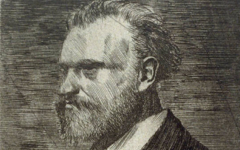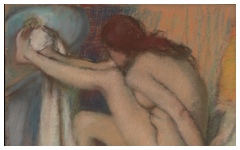Degas’ Little Dancer Aged Fourteen (1879-81)
Degas’ The Little Dancer Aged Fourteen captivates art lovers but is she art? If she is just a pretty little dancer, cleverly executed, she is - according to our definition of art - mere reproduction. If, though, she is Degas' imagination of himself taking one perfect, confident step onstage she is art. Does she represent that moment in Degas' mind when he conceived her through total identification with her performance? She ought to because she has mesmerized so many experts for so long. But how can we be sure?
Each time an artist begins a work they can feel like a young dancer about to take their first public step onstage. Each time is like the first time. Nerves combined with practiced professionalism produce the same calm, confident move as the Little Girl's. Besides artists often identify with children. Their innocence and purity can symbolize the perfection of a creative mind just as the infant Christ symbolizes the purified soul of each individual in esoteric Christianity.1 Degas stressed the dancer's age, fourteen, in the title too which suggests she is not just about to step on stage but into puberty and adulthood. She is full of symbolism.

L: Watteau, Gilles (c. 1718-19)
R: Degas, Little Dancer Aged Fourteen (1879-81) Metropolitan Museum, New York. The original wax sculpture is at National Gallery of Art, Washington DC; other bronze versions are at the Tate Liverpool, UK and The Sainsbury Centre for Visual Arts, Norwich, UK.
Click image to enlarge.
Many critics have described art as theatrical and performative. Rembrandt often painted figures as though on stage and Manet portrayed actors on several occasions.2 Watteau’s Gilles, an earlier French masterpiece (far left), presents an actor alone on stage and is widely recognized as a self-representation.3
Click next thumbnail to continue
When The Little Dancer was first exhibited people thought her ugly for reasons that do not concern us. What does is her concave nose, a feature common in children but rarer in adults. And, although a ballerina, Marie van Geothem, posed for the statue, it is well-known that Degas mixed his own physiognomy with features from other people's faces. Indeed he is one of the few artists widely recognized as practicing "face fusion."4
Click next thumbnail to continue

Left: Degas, Detail of Self-portrait (1855)
Right: Degas, Detail of photograph with Jacques-Emile Blanche and Jules Taschereau (1895)
Click image to enlarge.
Not surprisingly, perhaps, Degas’ most prominent facial characteristic was also a concave nose, longer than hers but concave nonetheless. It can be seen both in his early self-portrait (far left) and a detail of a photographic self-portrait taken forty years later (near left).
Click next thumbnail to continue

Left: Picasso, Detail of Degas Fantasizing. Faun Whispering in a Woman's Ear (1971)
Right: Picasso, Detail of An Artist: Degas Painting (1968)
Click image to enlarge.
The concave nose was such a defining characteristic of Degas' face that Picasso used it time and again in his depictions of Degas. Indeed it is only the presence of that nose that identifies Picasso’s figures as Degas.
Click next thumbnail to continue

Left: Detail of Degas' Little Dancer (1879-81)
Right: Detail inverted of Degas' Self-portrait (1855)
Click image to enlarge.
Now take another look at the Dancer. Her concave nose so resembles his that he must have intentionally fused his defining feature with the model's face. Her pouting lips and chin resemble his as well. The only other possibility is that he chose his model because she resembled him. These similarities are what artists look for: Picasso would not have missed them.
See conclusion below
The realism of the Little Dancer is misleading. The casual observer takes what they see for reality and enjoys the historical recreation. The imaginative observer, though, like the artist, will recognize the little dancer on the edge of puberty as a poetic representation of the artist's own androgynous mind conceiving the sculpture itself. That is art; mere reproduction is not.
More Works by Degas
Notes:
1. Annie Besant, Esoteric Christianity [first publ. 1905] (Quest Books) 2006, pp. 32-3
2. Svetlana Alpers, Rembrandt’s Enterprise: The Studio and the Market (The University of Chicago Press) 1990, pp. 80-1; Manet's stage paintings include The Tragic Actor, The Spanish Dancer, The Spanish Singer , The Cafe-Concert and Faure as Hamlet.
3. Dora Panofsky, “Gilles or Pierrot?: Iconographic Notes on Watteau” Gazette des Beaux-Arts, XXXIX (1952) p.330; Linda Nochlin, “Watteau: Some Questions of Interpretation”, Art in America 73 (Jan. 1985), p.71
4. Felix Baumann, "Degas' Early Self-Portraits" in Degas Portraits (Zurich: Kunsthaus) 1994, p. 164; Luzius Keller in "Portraiture between Tradition and Avant-Garde: Proust and Degas" in Degas Portraits, op.cit., p. 13; Mari Kálmán Meller, "Review: Degas Portraits. Zürich and Tübingen", Burlington Magazine 137, April 1995, p. 269; Carol Armstrong, Odd Man Out: Readings of the Work and Reputation of Edgar Degas (University of Chicago) 1991, p. 107
Original Publication Date on EPPH: 07 Mar 2011. | Updated: 0. © Simon Abrahams. Articles on this site are the copyright of Simon Abrahams. To use copyrighted material in print or other media for purposes beyond 'fair use', you must obtain permission from the copyright owner. Websites may link to this page without permission (please do) but may not reproduce the material on their own site without crediting Simon Abrahams and EPPH.




